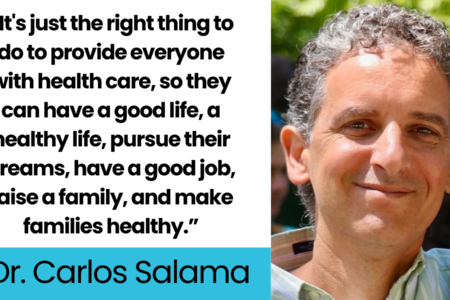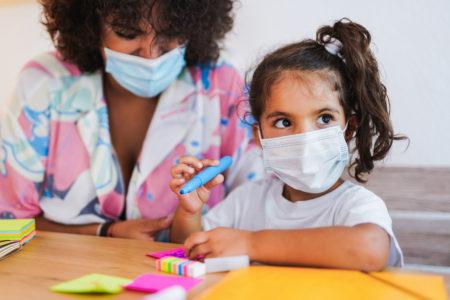Share On Social!
15-year-old Anna Valdez fidgeted in her chair as her eyes scanned the stethoscope, cotton balls, and other medical supplies on the far wall of the exam room.

Anna had traveled by bus to the hospital by herself, hoping to get some medical attention. But the uninsured California teenager did not receive the initial response she was anticipating from the resident physician.
After a discussion with the nurse though, he was more responsive to her concerns and began outlining Anna’s course of treatment.
“In that moment, I thought, ‘Wow, that is really impactful.’ I experienced a lot of bias and inequalities because I was poor, so I was really impressed that a nurse could have that kind of impact.”
At 16 years old, Anna found out she was pregnant.
She dropped out of high school; however, she knew that she needed to continue investing in her career.
By chance, she opened the Sunday newspaper one weekend and saw a featured picture of vocational nursing students.
“They were all very diverse. The article talked about how many of them came from disadvantaged backgrounds, were first generation college students living in poverty, and dealing with the exact same struggles as me,” Anna said. “I saw myself in that picture and so I called the phone number for the program. I thought if they can be successful, I could be successful too.”
Recalling her impactful experience with the hospital nurse, Anna chose to enroll in a RN program, which was “life-changing.”
After earning her RN degree, Anna began working in the emergency department of a hospital. She loved the fast-paced environment and the responsibility of preventing the development of healthcare-associated infections and the spread of infectious diseases.
She continued working in emergency nursing for 20 years, all while earning her bachelor’s, master’s, and PhD.
While pursuing her higher education degrees, Anna fell in love with teaching and decided to make a career change. She’s been teaching the next generation of diverse and infection control-oriented nurses ever since.
She Wrote the [Chapter] on PPE
Emerging from humble beginnings, Anna now holds many titles, including PhD, RN, CEN, CNE, CFRN, FAEN, and FAADN, and several roles:
- Department Chair of Nursing at Sonoma State University, California
- Senior Contributing Faculty at Walden University, Minnesota
- Chair of the Emergency Nurses Association (ENA) Diversity, Equity, and Inclusion (DEI) Committee
- Editor-in-Chief of Teaching and Learning in Nursing, the official journal of the Organization for Associate Degree Nursing
She is also nationally certified in emergency nursing, flight nursing, and nursing education.
Additionally, Anna has published over 25 peer-reviewed articles and contributed as an author to two emergency nursing books, including the Emergency Nursing Core Curriculum, of which she wrote the chapter on Personal Protection Equipment (PPE).
“I thought there wasn’t going to be a lot of interest. Nobody would want to read this chapter because it’s PPE – it can be boring,” Anna said. “At the time, I had no idea how important it would become and how much interest would probably be driven to that chapter.”
The COVID-19 pandemic highlighted longstanding gaps in infection control knowledge and understanding, leading many nurses and healthcare providers to refer to trusted sources of information, such as Anna’s textbook chapter.
“In terms of content, I really focused on the basic things, like how to properly wash your hands, the different types of disease transmission, and what PPE is needed for those different types of transmissions,” Anna said.
Four years later, Anna says, “I think there is a need for additional information and where to go for trusted information, such as the Centers for Disease Control and Prevention’s Project Firstline.”
An Infection Control Educator
Throughout her career as an educator, Anna has always integrated infection control education into her class curriculum, no matter the class focus.
“I really think infection control has to be taught throughout the curriculum, not just in the fundamentals class,” Anna said.
Perhaps ahead of the times, Anna’s emphasis on infection control education in her classes has proven vital for students entering the field, as nursing has changed a lot through the COVID-19 pandemic.
Infection control and how to properly use PPE has rightfully gained more attention in the clinical setting as a way for nurses and other frontline healthcare providers to slow the spread of disease among themselves, their colleagues, and their patients.
“I think that challenges with COVID-19 and infection control have been really significant for nursing, unlike anything I’ve seen in my career,” Anna said. “There was never a point in my career before COVID-19 where I needed to be in full PPE for the entire shift. But now nurses are needing to put on PPE and look at disease transmission routes every day.”
A Leader in Diversity, Equity, and Inclusion
In addition to being a leader in infection control, Anna has a personal mission to increase diversity, equity, and inclusion (DEI) among healthcare professionals, specifically nurses, to improve minority patient care.
“We know that having diverse nurses improves health outcomes of patients,” Anna said. “I have witnessed firsthand discrimination of my loved ones, so I have a personal drive and responsibility as a nurse to make sure that patients are getting unbiased care and that they have the best opportunity for wellness.”
Increased DEI among healthcare providers can also help improve infection control in vulnerable communities, such as Latinos, who were hit hard by the pandemic.
“Providers who racially and culturally share experiences with minoritized patients can better relate to their viewpoints and beliefs, potentially speak in the patient’s preferred language, and culturally tailor treatment plans,” Anna said. “These benefits can greatly improve health outcomes and infection control in these groups.”
“I’m Quite Happy Where I Am”
Anna plans to continue teaching the next generation of nurses for years to come. She hopes to continue contributing to infection control education, as well as her passion for DEI.
Looking back on her teenage years, she’s glad she picked up the newspaper that day.
From feeling like she had “no idea what to do with her life,” to finding her calling as a nurse and educator, Anna is making a profound impact on the way we address healthcare issues, including infection control.
“Nurses have the opportunity to become leaders and provide critical education and information about infection control,” Anna said. “I’m proud to be part of that.”
What Can You Do to Promote Infection Control in Your Healthcare Setting?
Access more information about infection prevention and control in healthcare by visiting resources from CDC Project Firstline.
Salud America! at UT Health San Antonio is working with the National Hispanic Medical Association to bring Project Firstline infection control educational content to healthcare workers, so they are equipped with the knowledge they need to protect themselves, their facilities, and their patients (Latinos and all communities) from infectious disease threats in healthcare settings.
You can read these articles:
- What is Project Firstline?
- What is the Goal of Infection Prevention and Control in Healthcare Settings?
- What’s a Virus?
- What is Ventilation and Why Does It Matter?
- Contact Time: What is It and How Does it Impact Infection Control?
- The Surprising Difference Between Cleaning and Disinfection
- What’s a Respiratory Droplet and Why Does It Matter?
- We Need to Talk about Hand Hygiene Again
- Why are Gowns, Gloves, and Eye Protection Recommended for COVID-19?
Learn More about Project Firstline!
Editor’s Note: This article is part of a collaboration between Salud America!, the National Hispanic Medical Association, and the CDC’s Project Firstline. To find resources training materials, and other tools to bolster knowledge and practice of infection control, visit Project Firstline and view Salud America!’s infection control content.
By The Numbers
142
Percent
Expected rise in Latino cancer cases in coming years
This success story was produced by Salud America! with support from the Robert Wood Johnson Foundation.
The stories are intended for educational and informative purposes. References to specific policymakers, individuals, schools, policies, or companies have been included solely to advance these purposes and do not constitute an endorsement, sponsorship, or recommendation. Stories are based on and told by real community members and are the opinions and views of the individuals whose stories are told. Organization and activities described were not supported by Salud America! or the Robert Wood Johnson Foundation and do not necessarily represent the views of Salud America! or the Robert Wood Johnson Foundation.




[…] The pandemic is another chapter in the bitter story of American racism and inequality. Black and Latinx people are being infected and are dying at much higher rates than white Americans. Many people of […]
[…] coronavirus has killed over 61,000 Latinos in America according to the CDC, accounting for over 18.2% of the total COVID deaths in the […]
[…] Whereas Hispanics make up 11% of D.C.’s inhabitants, they signify 19% of the COVID cases, and 14% of the deaths. Equally, 46% of D.C.’s residents are Black, they usually make up an alarming 75% […]
[…] and historical mistreatment. According to the U.S. Centers for Disease Control and Prevention, Latino and Black American communities are three times more likely to become infected with […]
[…] Covid pandemic has hit the Latino community particularly hard, and data from the nonprofit health equity advocacy group Salud America! shows Latinos lead in the 0-24 age […]
[…] the pandemic, Latinos took major blows, both in terms of COVID-19 cases and also from the economic recession under former President Donald Trump. Nearly half (49%) of […]
[…] the positive trend, the harm may have already been done. The pandemic has disproportionately impacted Latino communities. Reuters reported that election-related or political disinformation that […]
[…] pesar de la tendencia positiva, es posible que el daño ya esté hecho. La pandemia ha impactado desproporcionadamente Comunidades latinas. Reuters informó que la desinformación política o relacionada con las […]
[…] residentes blancos muestran una tasa mucho más baja con 10 muertes por cada 100,000 habitantes(8 9) . Los afroestadounidenses por su parte, denuncian subsistemas de salud que les segregan […]
[…] https://salud-america.org/coronavirus-case-rates-and-death-rates-for-latinos-in-the-united-states/ […]
[…] https://salud-america.org/coronavirus-case-rates-and-death-rates-for-latinos-in-the-united-states/ […]
[…] communities have the second-highest number of COVID-19 cases in the U.S. They’re also more likely to become hospitalized and die from the disease than other […]
[…] total, around 160,000 Latinos were killed by COVID-19. This accounts for 16% of the 1 million deaths in the country. The […]